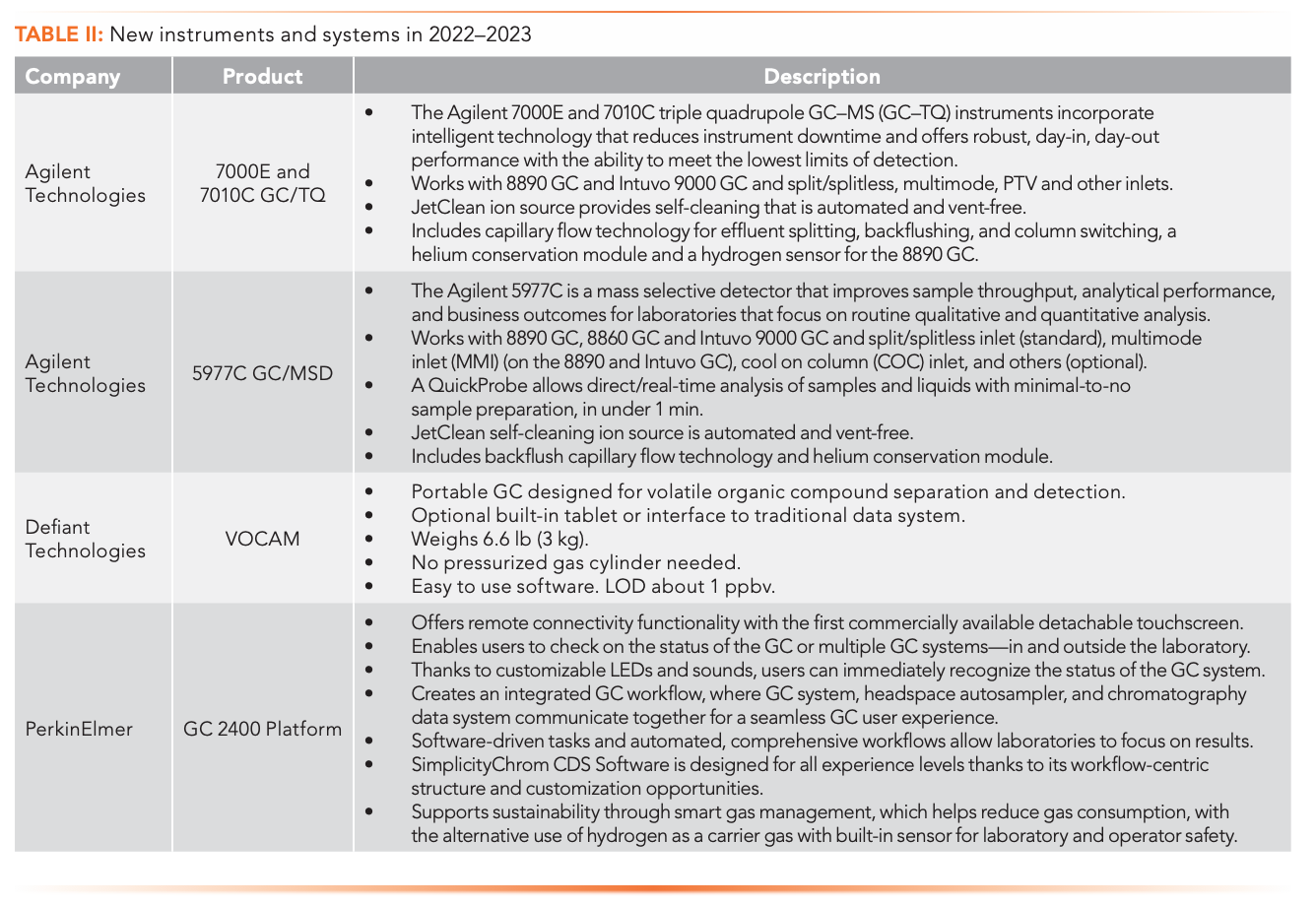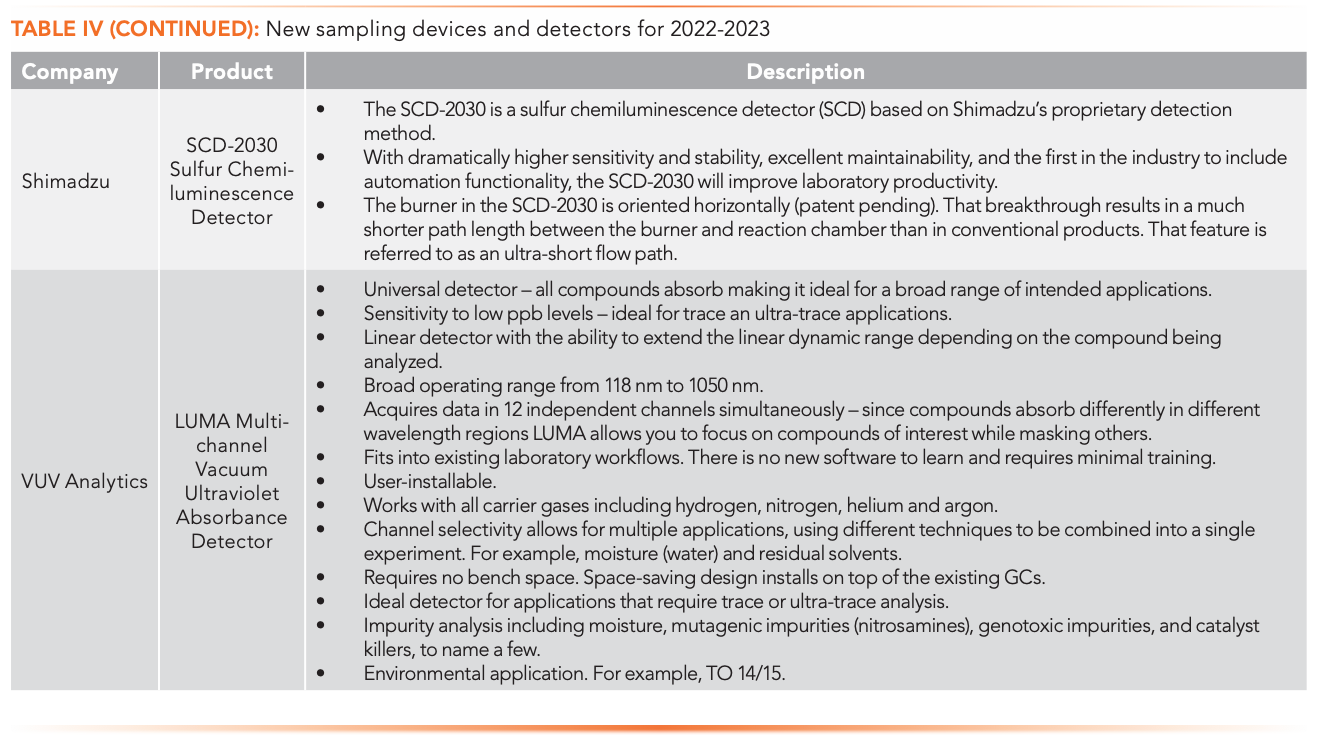Reflections from Pittcon 2023: An Examination of the New GC Products and Latest Developments in the GC Space
Over the last year, there have been several new gas chromatography (GC) products that have entered the market. Some of these products were advertised at Pittcon this week.
In this article, we examine these new products in more detail. The information presented in this article is based on vendors’ responses to questionnaires and additional information from press releases, websites, and product literature, not on actual use or experience of the author. Every effort has been made to collect accurate information but because of the preliminary nature of some of the material, LCGC North America cannot be responsible for errors or omissions. This column cannot be considered a complete record of all new GC products introduced in the past year because not all vendors responded to the questionnaire, nor is all the submitted information necessarily included here, because of the limited available space and the editors’ judgment as to its suitability. Table I provides a listing of the vendors highlighted in this review, some of whom are lesser known in the areas they are listed, showcased new products this year, or both. For a more complete picture of the GC space today, I encourage you to also review the three previous years’ reviews (1–3).

In new instruments, trends seen over the past few years toward smaller and more automated systems, systems that are more specialized, and spectrometric detectors continue this year. Table II shows a list of new complete instruments introduced ovethe past year. All these systems are designed with optimizing and simplifying workflows, operation, and maintenance. One concern is that systems are becoming so automated and convenient to use that training and education may be viewed as less necessary, a seemingly reasonable view until something goes wrong. They represent a range from a portable instrument about the size of a small briefcase, to a bench-top instrument to a range of three options for GC–MS and GC–MS/MS.

Stationary phases continue to be updated by most of the vendors, with nearly all making incremental improvements or showing new applications in their online application note libraries. The two new stationary phases that appear on this year’s survey were capillary column phases tailored to specific applications. These are highlighted in Table III. This incremental trend in capillary column stationary phase development for specific specialized problems continues. The 2021 review included two phases for fatty acid methyl esters and dioxins. Users are encouraged to contact and keep up with your column vendor; new phases and improvements are happening continuously.

In 2022–2023, developments in new accessories, sampling devices and detectors continue to trend toward simplifying analysis and making chromatographers’ work easier. We saw new advances in mass detection, with new ion sources, focused on making soft ionization techniques more accessible, a new vacuum ultraviolet detector and a new sulfur chemiluminescence detector. On the sampling side, new systems for purge and trap and gas mixing were presented. For more information on sample preparation, see the specific sample preparation article by Doug Raynie in next month’s issue of LCGC North America (4). As with the GC reviews, it is worthwhile to review the past two years as well for a complete picture of sample preparation products (5,6). Table IV provides a listing of products released in the past year that illustrate this trend. Many of the accessories are instrumental improvements in detectors and sampling devices.


Software and online resources continue to evolve along with the new technology. Two significantly updated systems for MS and GCxGC-MS analysis were released, along with updates to a free online method development platform. Along with the GC platform, a complimentary LC method development program is now available. Table V highlights these developments in software and online resources.

Our emergence from the pandemic provides more opportunities to continue education and training. Besides numerous short courses associated with Pittcon and other major conferences, many additional training and educational resources are available for 2023. The pandemic has resulted in much growth in online training and seminar offerings by vendors and training organizations, so check with your vendor. Opportunities for in-person short courses, seminars and training are moving again and are offered by most major instrument vendors and through many conferences and organizations, including the American Chemical Society, Eastern Analytical Symposium (Princeton, New Jersey, November 2023), local and regional chromatography discussion groups and, of course, Pittcon. LCGC’s online training system, ChromAcademy, is continuously adding content and is again hosting ChromTalks, a virtual symposium in May 2023.
As gas chromatography has passed its 70th birthday, development and innovation are ongoing and include all areas: sampling and supplies, new instruments, columns, detectors, data systems, and educational opportunities. I look forward to more innovation and advancements in the coming years, and I hope to see many of you at EAS 2023 in my home state of New Jersey, or at Pittcon 2024 in San Diego.
References
(1) Snow, N. H. New Gas Chromatography Products for 2021-2022. LCGC North Amer. 2022, 40 (4), 158–164. https://doi.org/10.56530/lcgc.na.la4187p6
(2) Snow, N. H. New Gas Chromatography Products for 2020-2021. LCGC North Amer. 2021, 39 (4), 167–171.
(3) Snow, N. H. New Gas Chromatography Products for 2019-2020. LCGC North Amer. 2020, 38 (5), 277–290.
(4) Raynie, D. E. New Sample Preparation Products and Accessories. LCGC North Amer. 2023, 41 (5), in production.
(5) Raynie, D. E. New Sample Preparation Products and Accessories. LCGC North Amer. 2022, 40 (5), 218–222. https://doi.org/10.56530/lcgc.na.hx9178z7
(6) Raynie, D. E. New Sample Preparation Products and Accessories. LCGC North Amer. 2021, 39 (5), 228–231.
ABOUT THE AUTHOR
Nicholas H. Snow is the Founding Endowed Professor in the Department of Chemistry and Biochemistry at Seton Hall University, and an Adjunct Professor of Medical Science. During his 30 years as a chromatographer, he has published more than 70 refereed articles and book chapters and has given more than 200 presentations and short courses. He is interested in the fundamentals and applications of separation science, especially gas chromatography, sampling, and sample preparation for chemical analysis. His research group is very active, with ongoing projects using GC, GC–MS, two-dimensional GC, and extraction methods including headspace, liquid–liquid extraction, and solid-phase microextraction. Direct correspondence to: LCGCedit@mmhgroup.com

New Study Reviews Chromatography Methods for Flavonoid Analysis
April 21st 2025Flavonoids are widely used metabolites that carry out various functions in different industries, such as food and cosmetics. Detecting, separating, and quantifying them in fruit species can be a complicated process.

.png&w=3840&q=75)

.png&w=3840&q=75)



.png&w=3840&q=75)



.png&w=3840&q=75)



